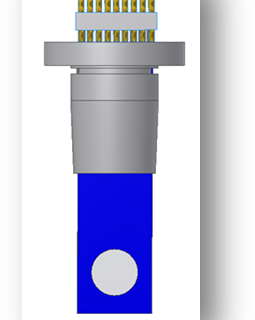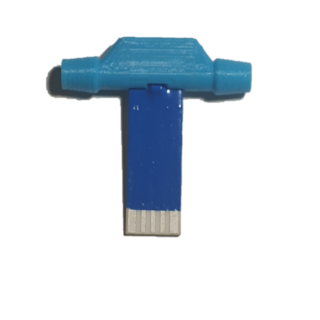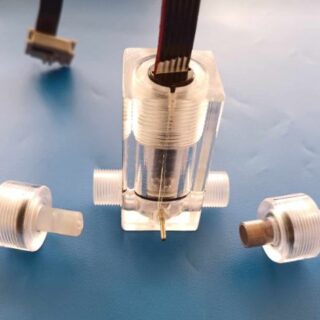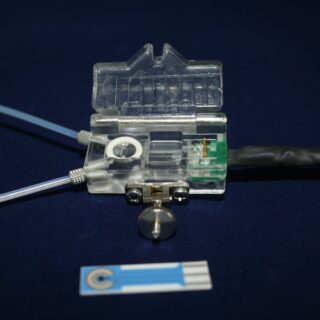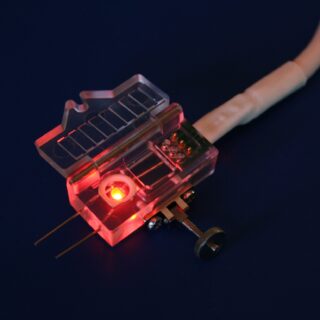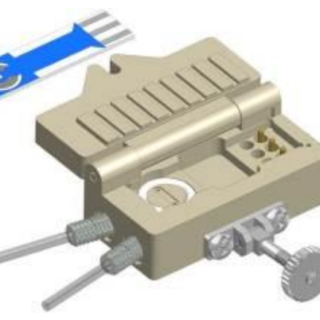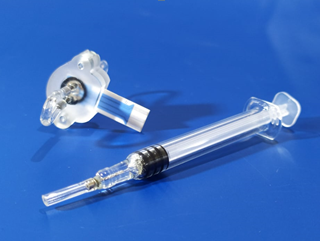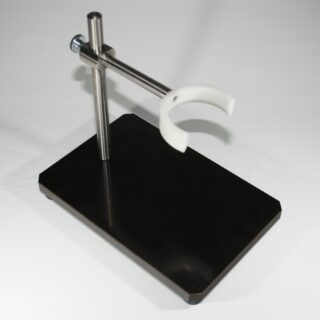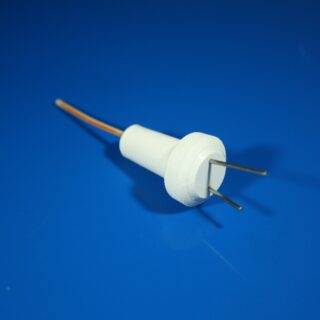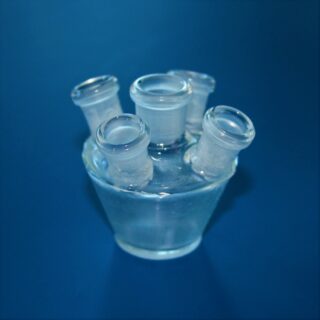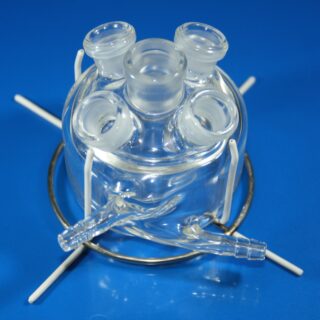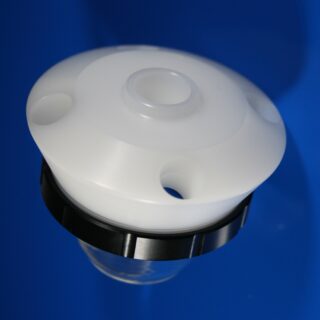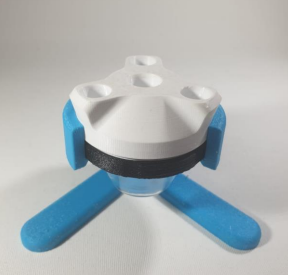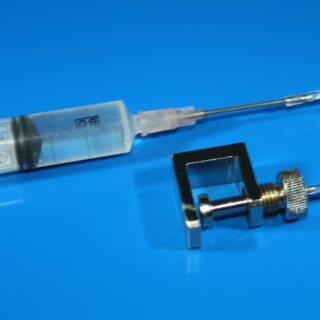Category
- CUSTOMER SERVICES
- NEW PRODUCTS
- Sensors and electrodes
- Custom made and Modified Screen Printed Electrodes
- Stirrers
- Cables and connectors
- Cell
- Potentiostats
- Manual Screen Printer
- Minithermostat
- Pumps
- Accessories
- Kits & Sets
- Discounted SPEs (at a reduced price with visual defects/inconsistancies, but fully functional)
Category: Cell
Cell
Showing all 16 results
-
CC4 Electrochemical Sensor Cell
Read moreConductometric sensor integrated with a specialised cell to create the CC4 Electrochemical Sensor Cell.
The CC4 sensor is formed on a corundum ceramic base. The structure consists of two platinum working electrodes (Pt WE) and an integrated thermistor on the opposite side covered by a dielectric protection layer.
Possible use of the CC4 sensor:
- Quality control of distillation
- Checking of waste waters from treatment plants, i.e. checking of Salt content
- …
-
FC.1ISE.1REF Flow cell for single ion selective electrode with integrated stirring
Read moreThe flow cell with integrated stirring and reduced hydrodynamic noise is designed for the determination of single analyte using one miniature ion-selective electrode (ISE) and one miniature reference electrode with a diameter of 6 mm and length of 60 mm.
Rotation speed of integrated stirrer: 10-4000 rmp.
Miniature ion-selective electrodes and reference electrode were designed for integration into the flow cell for determination of Cl-, K+, Ca2+ and Na+ ions.
In flow mode, the system can operate automatically. The speed of the integrated stirrer can also be controlled by applying the corresponding voltage to the motor, connected to a stabilized source.
The flow cell with one selected ISE can be used for:
- Automatic or semi-automatic measurement of concentration of Cl-, K+, Ca2+ and Na+ ions in various solutions (following prior calibration)
- For continuous measurement of changes in concentration of Cl-, K+, Ca2+ and Na+ ions.
* For this product, we recommend our customers use the Training Service from BVT.
(https://bvt.cz/produkt/offer-of-long-term-automated-measurements-on-bvt-apparatus/)
-
FC2.TL.* PMMA Flow Cell
Read moreThe flow cell enables the use of Screen printed sensors in a flow through arrangement.
The flow cell is suitable for sensors of type AC1, AC2, CC1, CC2 and CC3.
The Screen printed sensor is inserted into the slit of cell and tightened by closing of the door. The cell ensures the wall-jet flow around the working electrode and it is optimised so that no air bubbles cumulate in the cell. The cell contains also the contact and output cable.
With the sensors enclosed in a flow cell, it is possible to measure semi-automatically or automatically using a pump or liquid switch for sample supply. Under such conditions, maximum measurement reproducibility is ensured.
-
FC3.TL.* LED Flow Cell
Read moreThe flow cell enables the use of Screen printed sensors in a flow through arrangement for spectroelectrochemical measurements1,2.
The flow cell is suitable for sensors of type AC1, AC2, CC1, CC2 and CC3.
The Screen printed sensor is inserted into the slit of cell and tightened by closing of the door. The cell ensures the wall-jet flow around the working electrode and it is optimised so that no air bubbles cumulate in the cell. The cell contains also the contact and output cable.
With the sensors enclosed in a flow cell, it is possible to measure semi-automatically or automatically using a pump or liquid switch for sample supply. Under such conditions, maximum measurement reproducibility is ensured.
LED Specification:
Diameter: 3 mm
Wave lenght range: 350 – 2000 nm- Standard: 620 – 630 nm
(If special laser LED is used the band width and other parameters can be specified on demand)
Emitting angle: 10 – 120 deg
- Standard: 60 deg
Iv (emitted power): 750 – 1120 mcd
I max: 20 mA - Standard: 620 – 630 nm
-
FC4.TL.* PEEK Flow Cell
Read moreThe FC4.TL flow cell is made of PEEK and enables the use of Screen printed sensors in a flow through arrangement.
It has teflon endings permitting a fully compatible connection to chromatography tubing.
The flow cell is suitable for sensors of type AC1, AC2, CC1, CC2 and CC3.
The Screen printed sensor is inserted into the slit of cell and tightened by closing of the door. The cell ensures the wall-jet flow around the working electrode and it is optimised so that no air bubbles cumulate in the cell. The cell contains also the contact and output cable.
With the sensors enclosed in a flow cell, it is possible to measure semi-automatically or automatically using a pump or liquid switch for sample supply. Under such conditions, maximum measurement reproducibility is ensured.
-
MDC1 Microdialysis Catheter for “in vitro” Measurement
Read moreThe microflow cell FC2 (BVT Technologies, a.s.) connected with microdialysis catheter PME011 (Probe Scientific, Ltd., UK) enables continuous monitoring of low-molecular substances in circulating blood without withdrawing blood from the tested body. (The device is not approved for human use as a whole; the microdialysis catheter has the approval for medical use).
SPE electrochemical sensors and biosensors can be enclosed in the FC2 cell – e.g. the AC1.GOD sensor for measuring glucose. The advantage of this system is the defined and sterile conditions under which the sample is fed through the microdialysis catheter to the working electrode of the SPE sensor.
The device can be also used for measurement in fermentation reactors, in subcutaneous tissues or in special scientific apparatuses. The main advantage of this catheter is in a special membrane which produces a “plasma-like” or “prefiltered sample” sample without the need for blood centrifugation or deproteinization.
MDC1 makes online monitoring of different blood parameters (biochemical compounds actual concentration or kinetics of enzymatic reactions) possible. The device is also convenient for pharmacological studies. The device can be used only for non human applications.
-
SIRE Sensor Cell Set (Sensor with Injectable Recognition Element)
Read moreThe SIRE Sensor Cell Set consists of a sensor with an integrated non-removable specialised chamber.
The set also contains a syringe which will allow the injection of the recognition element (Enzyme).
The SIRE Sensor Cell uses the concept of soluble enzymes into a reaction chamber separated from the sample by a semi permeable dialysis membrane. The analyte (for example maltose), enters into the reaction chamber by diffusion. The analyte reacts with the recognition enzymes creating H2O2 which is oxidized on a screen printed Pt electrode. The current corresponds to the amount of analyte.* For this product, we recommend our customers use the Training Service from BVT.
(https://bvt.cz/produkt/offer-of-long-term-automated-measurements-on-bvt-apparatus/)
-
STP1.* Stoppers for Cells
Read moreStoppers are formed from white PBTP (Polybutylenterephtalate). They are used for covering of the glass cells produced by BVT.
The system with the stopper is closed and space is prevent from solution evaporation.
Model Recommended Vessel Termination STP1.S TC4, TC5, TC6 Stopper for TC4, TC5, TC6 STP1.1 TC4, TC5, TC6 Stopper with bubbling STP1.2 TC4, TC5, TC6 Stopper with tubing STP1.3 TC4, TC5, TC6 Middle stopper -
TC4 Electrochemical Glass Cell
Read moreSimple borosilicate glass cell serves for electrochemical measurements.
The temperature of the analyzed solution can be controlled when placing the cell in MT1-1 minithermostat.
Cell openings are designed for electrochemical sensors connector KA1.C, classical electrodes WCEc, ACEc, RCEc and stirrer ST1, ST3 separately.
-
TC5 Electrochemical Glass Cell
Read moreBorosilicate glass cell serves for electrochemical measurements. The cell is jacketed.
The analyzed solution can be thermostated by external thermostat.
Cell openings are designed for electrochemical sensors connector KA1.C, classical electrodes WCEc, ACEc, RCEc and stirrer ST1, ST3 separately.
-
TC6 Electrochemical Glass Cell
Read moreBorosilicate glass cell serves for electrochemical measurements.
The analyzed solution can be thermostated by minithermostat MT1-1.
Cell openings are designed for electrochemical sensors connector KA1.C, classical electrodes WCEc, ACEc, RCEc and stirrer ST1, ST3 separately.
The device enables the measurement with inserted samples.
-
TC7 Electrochemical Glass Cell
Read moreThe TC7 is a low cost Glass Cell that is ideal for students and basic lab measurements.
The TC7 comes with a stand, specially designed for it, and the stand provides more stability and ease of use.
The Borosilicate glass cell serves for electrochemical measurements. Cell openings are designed for the SPE Electrochemical Sensors Connector KA1.C,Classical Electrodes WCEc, ACEc, RCEc, STP1.*
Stoppers for Cells, and Stirrer’s ST1 and ST3 separately.
The device enables the measurement with inserted samples.
-
TC9 Electrochemical Glass Cell
Read moreBorosilicate glass cell serves for electrochemical measurements.
The analyzed solution can be thermostated by external thermostat MT1-1.
Cell openings are designed for stirrer ST9 or mini RDE and connector KA9.s with folder for electrochemical sensor AC9C, classical electrodes WCEc, ACEc and RCEc. The device enables the measurement with inserted samples.
-
WI Wash Instrument for FC
Read moreWashing instrument for flow cells FC2, FC3 and FC4.
Flow cells FC2, FC3 and FC4 can be fouled by buffer salts, standard or sample substances especially in the tubing that brings measured liquid to the sensor.
The salts embed namely in the edges of drilled openings. It causes decrease of the flow area, thereby flow rate. These negative influences decrease the signal and measurement reliability. Most frequently it happens when high salt concentration solutions or solutions with impurities are used. The flows cell can be washed by pressured water using syringe.

